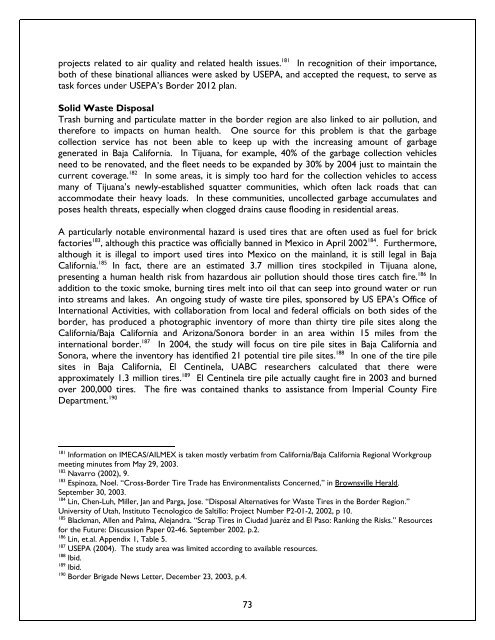Blurred Borders - International Community Foundation
Blurred Borders - International Community Foundation
Blurred Borders - International Community Foundation
Create successful ePaper yourself
Turn your PDF publications into a flip-book with our unique Google optimized e-Paper software.
projects related to air quality and related health issues. 181 In recognition of their importance,<br />
both of these binational alliances were asked by USEPA, and accepted the request, to serve as<br />
task forces under USEPA’s Border 2012 plan.<br />
Solid Waste Disposal<br />
Trash burning and particulate matter in the border region are also linked to air pollution, and<br />
therefore to impacts on human health. One source for this problem is that the garbage<br />
collection service has not been able to keep up with the increasing amount of garbage<br />
generated in Baja California. In Tijuana, for example, 40% of the garbage collection vehicles<br />
need to be renovated, and the fleet needs to be expanded by 30% by 2004 just to maintain the<br />
current coverage. 182 In some areas, it is simply too hard for the collection vehicles to access<br />
many of Tijuana’s newly-established squatter communities, which often lack roads that can<br />
accommodate their heavy loads. In these communities, uncollected garbage accumulates and<br />
poses health threats, especially when clogged drains cause flooding in residential areas.<br />
A particularly notable environmental hazard is used tires that are often used as fuel for brick<br />
factories 183 , although this practice was officially banned in Mexico in April 2002 184 . Furthermore,<br />
although it is illegal to import used tires into Mexico on the mainland, it is still legal in Baja<br />
California. 185 In fact, there are an estimated 3.7 million tires stockpiled in Tijuana alone,<br />
presenting a human health risk from hazardous air pollution should those tires catch fire. 186 In<br />
addition to the toxic smoke, burning tires melt into oil that can seep into ground water or run<br />
into streams and lakes. An ongoing study of waste tire piles, sponsored by US EPA’s Office of<br />
<strong>International</strong> Activities, with collaboration from local and federal officials on both sides of the<br />
border, has produced a photographic inventory of more than thirty tire pile sites along the<br />
California/Baja California and Arizona/Sonora border in an area within 15 miles from the<br />
international border. 187 In 2004, the study will focus on tire pile sites in Baja California and<br />
Sonora, where the inventory has identified 21 potential tire pile sites. 188 In one of the tire pile<br />
sites in Baja California, El Centinela, UABC researchers calculated that there were<br />
approximately 1.3 million tires. 189 El Centinela tire pile actually caught fire in 2003 and burned<br />
over 200,000 tires. The fire was contained thanks to assistance from Imperial County Fire<br />
Department. 190<br />
181<br />
Information on IMECAS/AILMEX is taken mostly verbatim from California/Baja California Regional Workgroup<br />
meeting minutes from May 29, 2003.<br />
182<br />
Navarro (2002), 9.<br />
183<br />
Espinoza, Noel. “Cross-Border Tire Trade has Environmentalists Concerned,” in Brownsville Herald.<br />
September 30, 2003.<br />
184<br />
Lin, Chen-Luh, Miller, Jan and Parga, Jose. “Disposal Alternatives for Waste Tires in the Border Region.”<br />
University of Utah, Instituto Tecnologico de Saltillo: Project Number P2-01-2, 2002, p 10.<br />
185<br />
Blackman, Allen and Palma, Alejandra. “Scrap Tires in Ciudad Juaréz and El Paso: Ranking the Risks.” Resources<br />
for the Future: Discussion Paper 02-46. September 2002. p.2.<br />
186<br />
Lin, et.al. Appendix 1, Table 5.<br />
187<br />
USEPA (2004). The study area was limited according to available resources.<br />
188<br />
Ibid.<br />
189<br />
Ibid.<br />
190<br />
Border Brigade News Letter, December 23, 2003, p.4.<br />
73















